In an earlier blog, “Trash Destroys,” I mentioned an area in Chesapeake, VA known by locals as “the curve,” where I’d come across a diverse pile of junk that included golf shoes, Gatorade bottles, foam boot liners, and a lawn chair. I remarked, “This jumbled mess of a trash pile was just feet from an Elizabeth River tributary. And that’ll be its destination following a rainstorm, a higher-than-usual tide, or some other event.” Fortunately, city workers hauled the trash pile away. But another pile began to form just a few days later.

Lakeside Park
In that post, I referred to the scene I’d encountered as “our trash-filled world in miniature.” Well, I don’t think it’s too far-fetched to say that another area in Chesapeake, Lakeside Park, a small 11-acre city park, is in many ways the bird world in miniature. Since spring migration began in earnest in April of this year, I’ve observed activity there that encapsulates so much of what we’ve learned about bird life and behavior.
Birds Are Migratory
First of all, most birds are migratory. Birds migrate to this park or through this park in good numbers. I made that point in a message that I sent out to several different Facebook groups in April:
Hi all, DO NOT, DO NOT, DO NOT neglect small town and city parks during spring migration. Migrating birds often concentrate in these “less desirable” places, and breeders head there, too. Lakeside Park is not even a mile from where we live in Chesapeake. I’ve only walked through the park or have driven by, but never once considered birding there. There aren’t that many trees, there’s always a fair amount of trash, it’s sandwiched between a school and a busy road, and it’s a known hangout spot. But my friend, Laura Mae, started birding there and just put the park on the birding map. I followed suit, and together we’ve tallied close to 50 species, including 5 migrant warbler species (and both waterthrushes)! Laura also discovered nesting Yellow-crowned Night Herons there, and it’s very possible that more difficult to locate and study Green Herons nest there as well. So, sure, you can travel to the local National Wildlife Refuges, or to Wildlife Management Areas or state parks, but you might very well have a certifiable birding hotspot in a town or city park in your own backyard. Good luck!
Not long after I sent out that message, I discovered my first of about a dozen (a dozen!!!) Green Heron nests there. Green Herons, like many birds that show up in this park, are neotropical migrants that spend each winter in the tropics but migrate north each spring to breed.
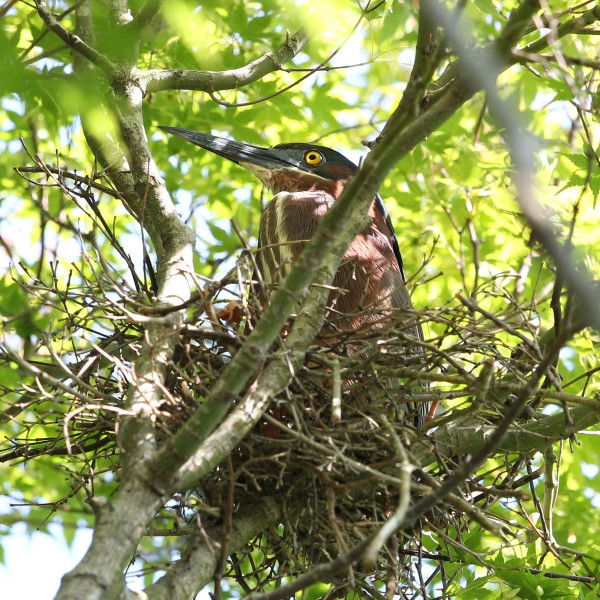
Birds Pursue Resources
People often wonder why birds migrate. “Why do birds face the rigors and risks of long-distance flight,” they ask, “when there are probably ample resources in their wintering grounds?” Great question.
Migration is a complex topic, but one reason birds migrate in the spring is to take advantage of the Northern Hemisphere “insect explosion.” Insects are a critical part of most birds’ diets and also the diets of their offspring. I noticed that insect explosion from the first day I began birding at Lakeside, and that explosion continues unabated. I’ve watched Green Herons snag them from the air, catch them in the grass, and take them from the water.

Birds also migrate north in the spring because there’s less competition there for good nest sites, and because they enjoy greater reproductive success there, to boot—i.e, their brood sizes tend to be larger. Lakeside Park not only has good nest sites in abundance—and there appears to be little, if any, competition for them—but from what I can tell, the brood sizes there average a whopping 4 birds or more.

Birds Specialize
Green Herons, park summer residents, as we’ve learned, are great examples of birds as specialists. They seek out well-concealed (and almost impossible to photograph) nest sites usually 30-40 feet up in trees that are near or over water. And they almost always build their nests in a fork and beneath the overhanging branches of the top of the crown. Both sexes cooperate in the building of the nest.
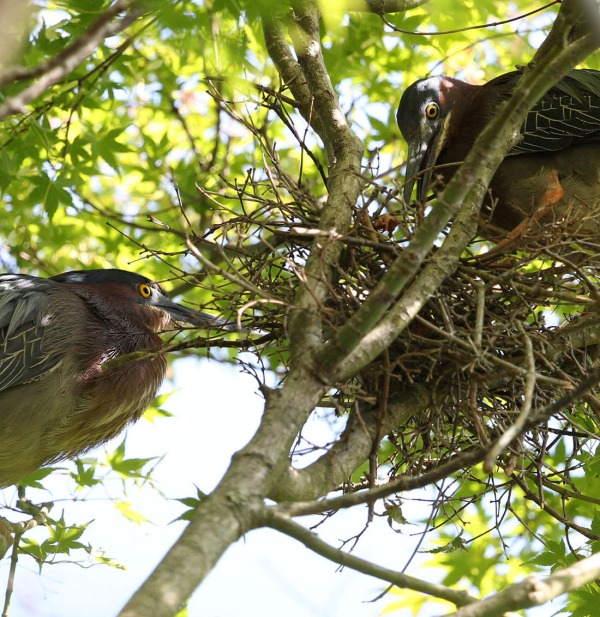
Green Herons are specialists in other ways. They feed primarily in shallow water, and they take mostly fish. But they also feed on invertebrates such as insects, showing a preference for dragonflies and damselflies. Below is a distant photo of an adult standing on the lake’s algal bloom while grabbing a minnow. Birds are deceptively light, whereas algae mats can be deceptively heavy.

And here is a relative close-up of a “land-based” adult bird snagging a dragonfly.
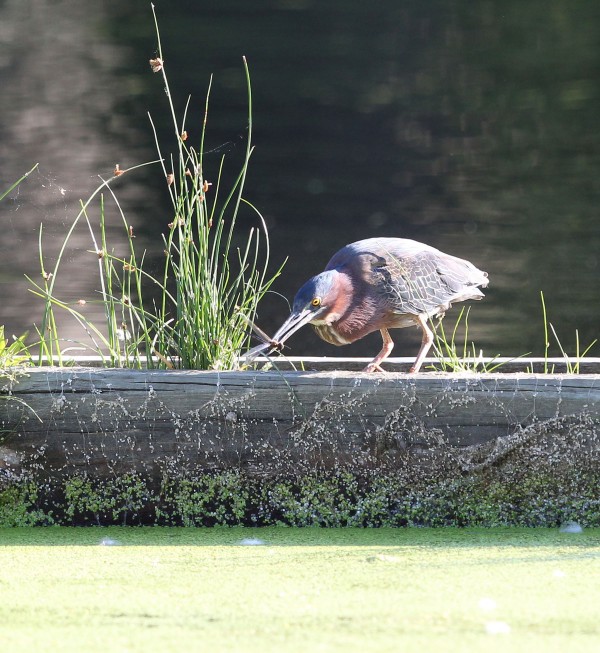
Both Bird Parents Provide Care
I’ve written that Ospreys and Killdeer provide biparental care. Both Osprey and Killdeer parents participate in everything from nest building to rearing young. If you take a look at the opening paragraphs of my earlier piece, “The Killdeer Saga,” you’ll get a sense of this cooperation.
Well, Green Herons, Yellow-crowned Night Herons, and most other bird species provide that kind of care, as well, not to mention that most bird species are monogamous.
Case in point: I observed the Green Heron pair above as they built their nest back at the end of May. And I also watched as both parents later tended their nestlings. Green Heron nestlings, by the way, spend quite a bit of time just outside the nest and climbing around on nearby branches before they officially fledge. They strengthen their feet, legs, and wings that way.
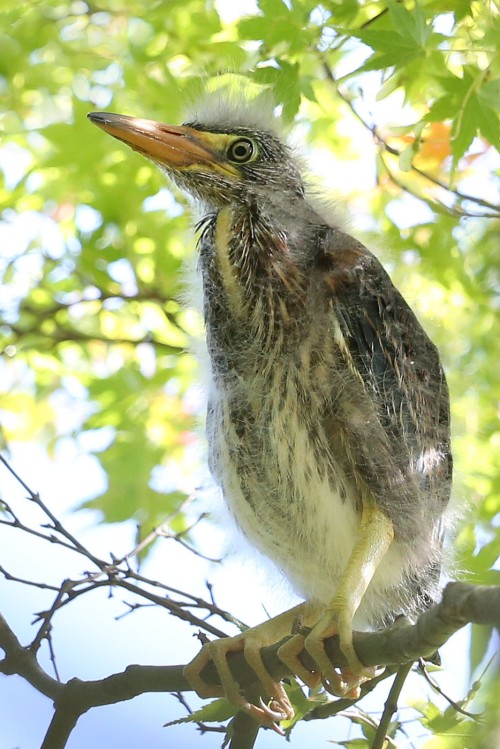
The Green Heron biparental care continued even after the 4 chicks in the nest successfully fledged in early July. The parents and their young appeared to remain in close contact.
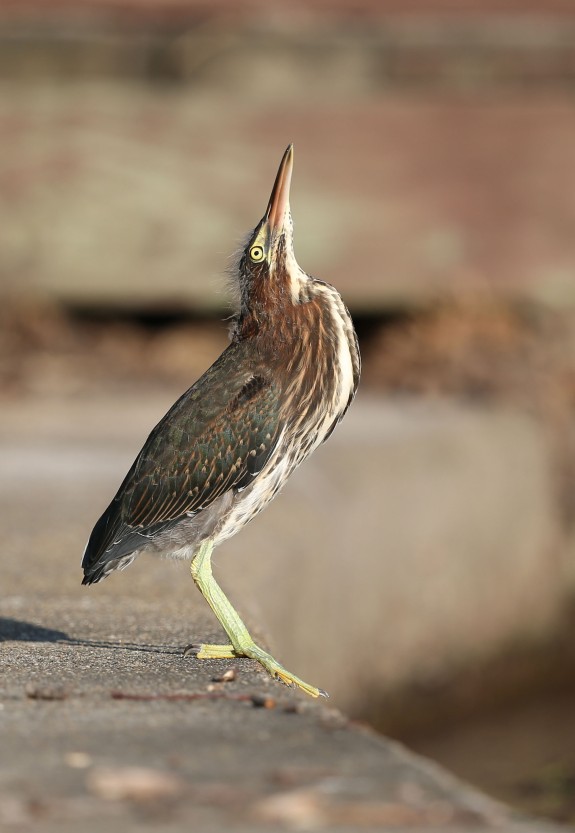
For example, this young and rapidly transitioning juvenile heard a familiar “skeow” as it foraged. It quickly assumed the “bittern posture,” spotted and tracked its parent as it flew overhead, and then up and followed after it until both birds landed in a nearby tree.
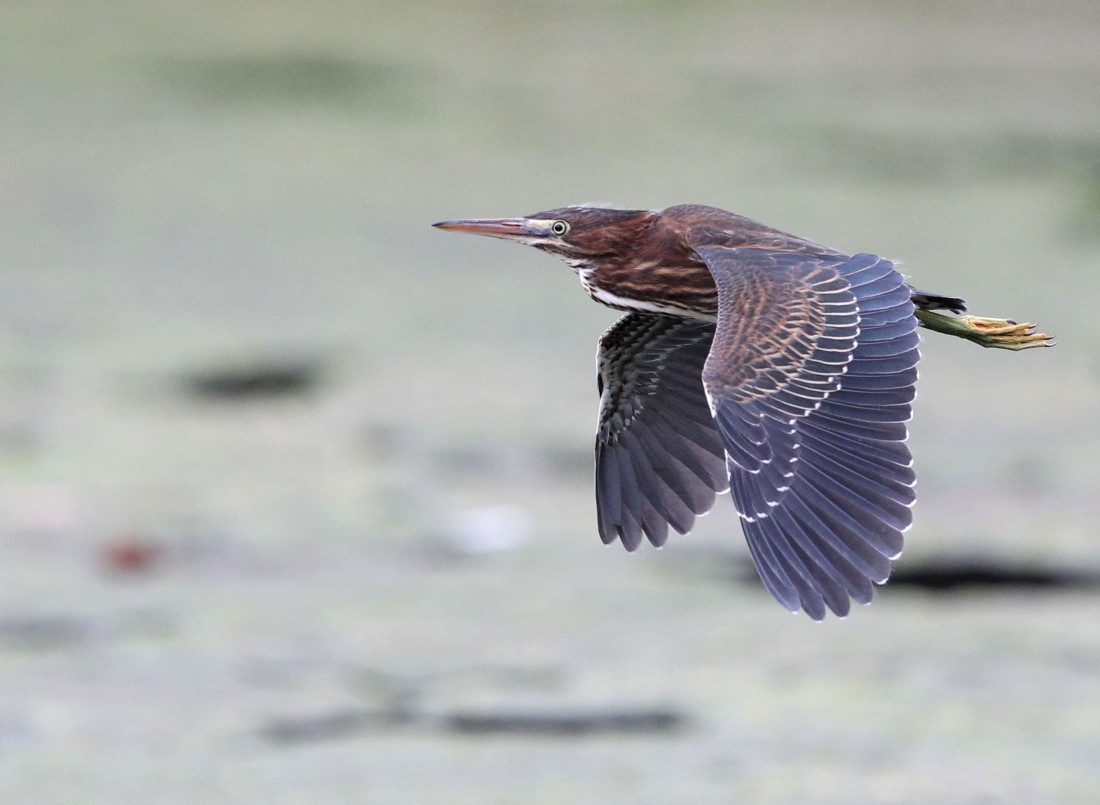
Birds Have Remarkable Skills
This leads me to another point. Birds have remarkable skills, especially in the sensory realm. I’ve written about their extraordinary flight skills, of which we’re all rightly in awe. You’ll read there that David Sibley has referred to the avian wing as a “marvel of engineering.” But I wasn’t fully aware of how well-developed and keen birds’ senses of sight and hearing were.
The little bird above was able to clearly pick out its parent’s call and then track its parent’s flight movements. I’ve observed juveniles responding to other Green Herons and to other environmental sounds like sirens, barking dogs, and children’s screams, as well. And I’ve watched as both young and older birds spotted nearly imperceptible minnow movement from the lake shore or the park bridge and flew out to grab them, as the adult bird had done in the photo above. I’ve watched, too, as young Green Herons tracked, struck at, and snatched darting dragonflies or damselflies, pulling them right out of thin air, or spotted, approached, and slowly stalked them as they rested on the ground some 20-30 feet away.
Birds Receive Training
“Though there’s a degree of hard-wiring in place, and instinct certainly kicks in, there’s still a learning curve for these youngsters.” I wrote those words about juvenile Yellow-crowned Night Herons in my earlier blog, “Sumer is Agoin Out.” But those words apply to juvenile Green Herons and to other young birds, as well.
Here are some photos that capture their lack of skill and just where they are on the learning curve. This young bird lost its balance and landed in the muck as it tried to capture its prey.
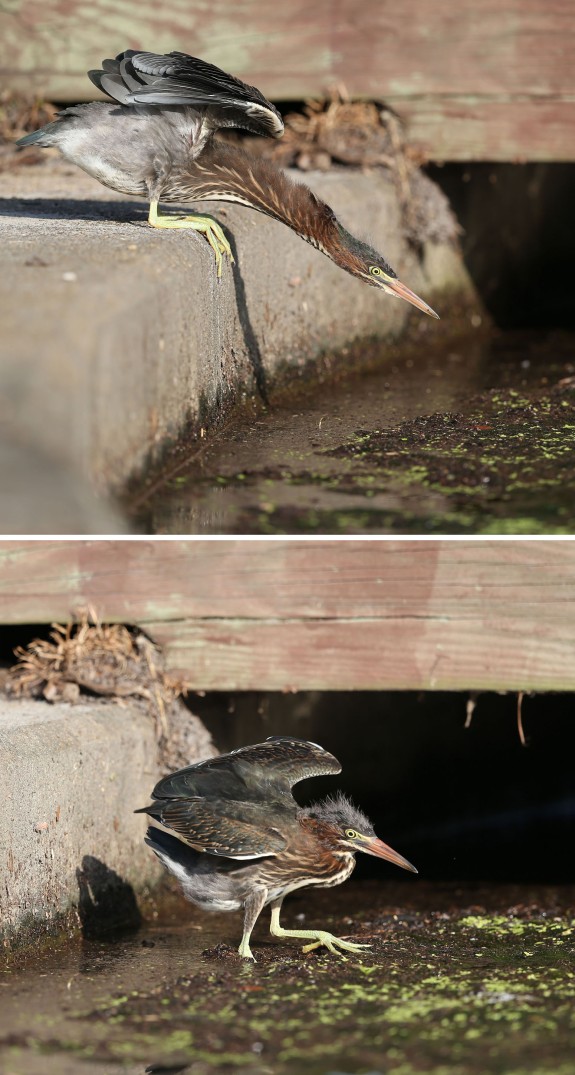
Fortunately, the bird, which had been trying to nab a fish or an insect, landed on the algal bloom. I told my wife later on that I would have rescued it had it been in jeopardy. Little did I know that Green Herons have actually been observed swimming.
Here’s a young Green Heron grabbing a feather followed by another one grabbing a piece of wood. Both birds spit their “quarries” out afterward, yet repeated the picking up/spitting out process numerous times. It’s also possible, of course, that these young birds were just having trouble distinguishing what’s edible from what’s not and were just testing things out.
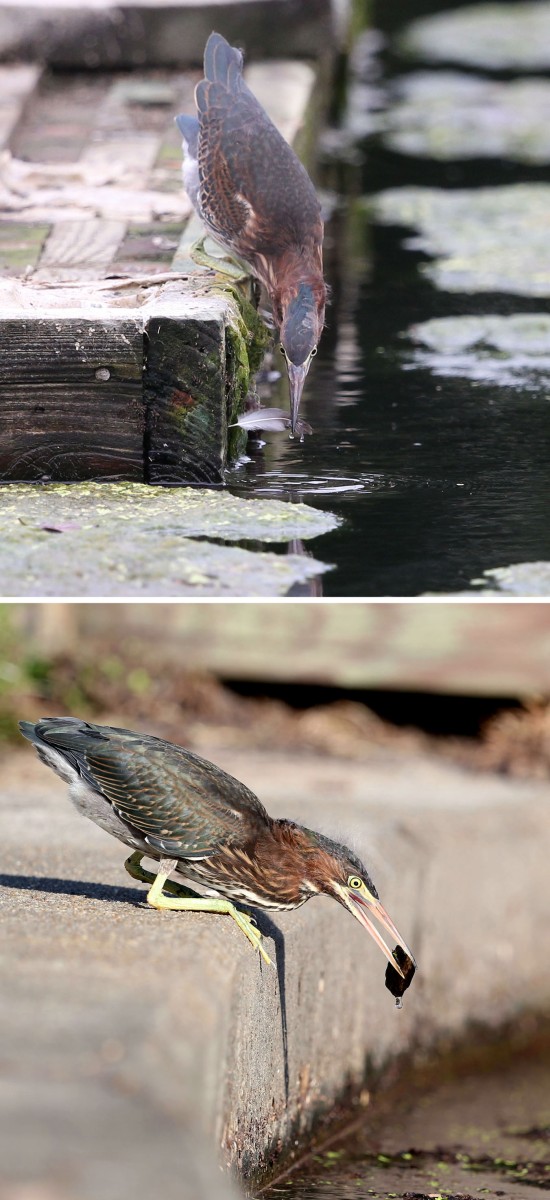
And here is a juvenile Yellow-crowned Night Heron doing the very same thing. We could say that all these birds were learning by trial and error.
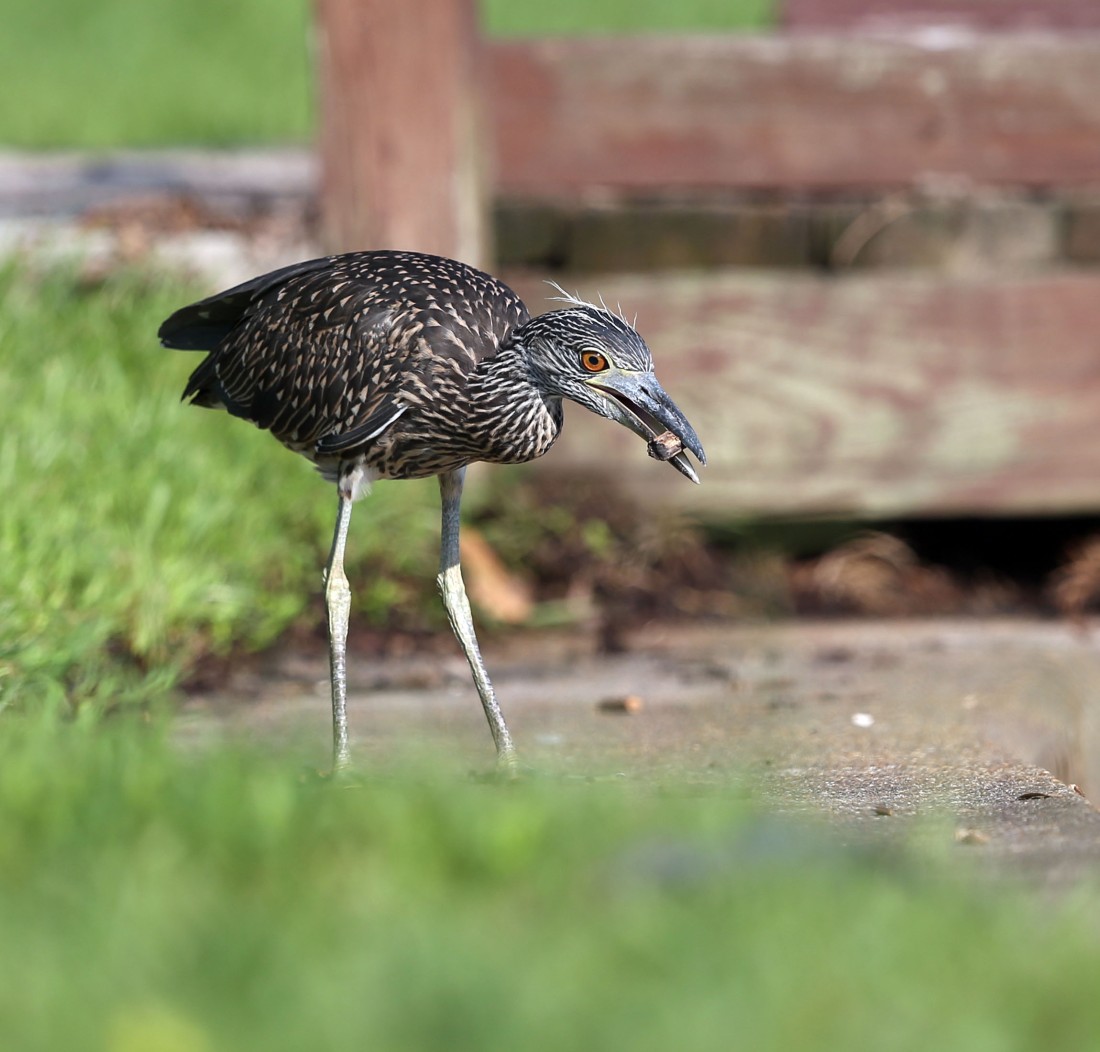
But juveniles also learn through observation. Here’s a photo of a what looks like a young bird coming in for a landing. The other young bird—on the left—appears to be studying the landing closely. I imagine the the bird on the right to be the adult tutor. Though all the points of interest here aren’t in focus, I still like the shot and what it tells us about birds.

A Final Word
Thank you, one and all, for reading. We’re really at our word limit, not to mention our time limit, so we’ll skip the usual closing sections. I’ll probably continue to write about this special city park, this special “bird world in miniature,” in the next blog, so please stay tuned.
I’d like to leave you with a final recording and photo. The recording will give you some idea regarding the Lakeside Park soundscape. It features an adult Green Heron returning to its nest, a nest with 3 very young nestlings, and calling repeatedly. Beginning at just under 4 minutes, a Blue Jay alights a few feet from the nest and the parent, in full protective parent mode, goes a little berserk. The final photo pretty much speaks for itself.
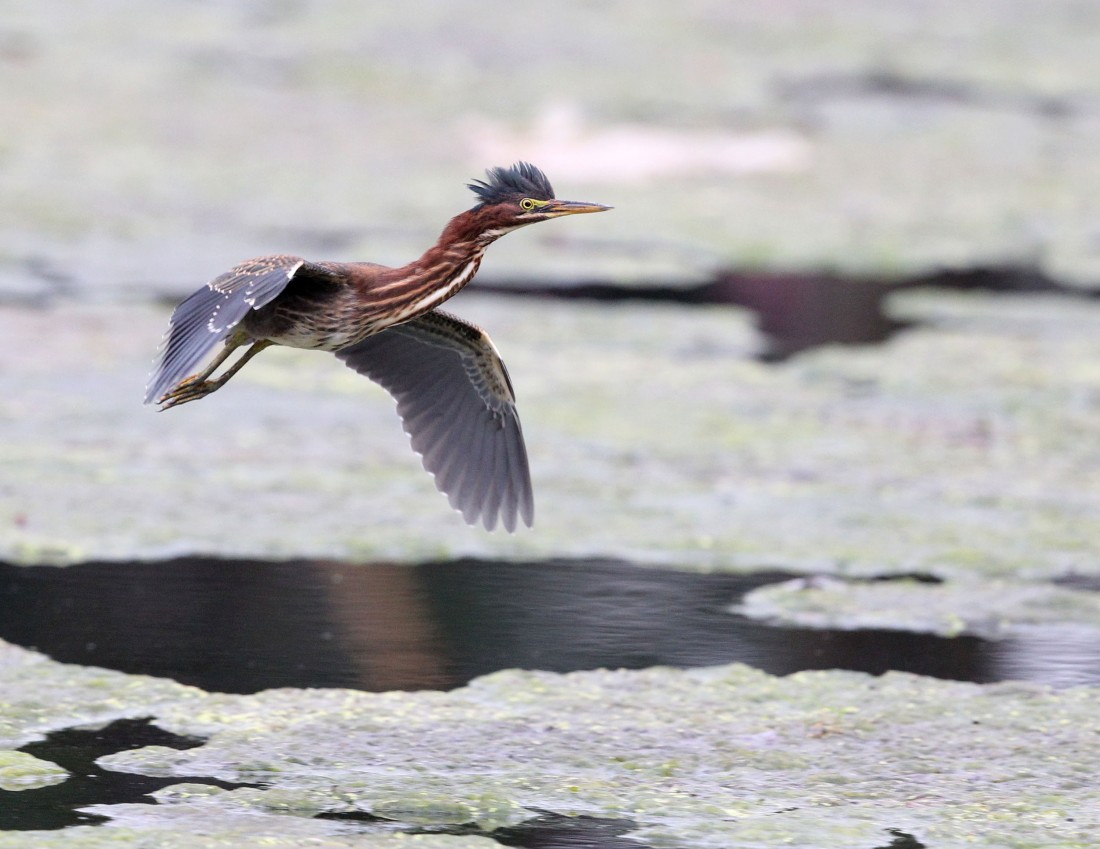
Thank you so much@ I am new at this. And.in.awe.
LikeLike
Thanks so much. You’re new to birding, blogging, or photography?
LikeLike
Beautiful and inspiring . Thank you.
LikeLike
Thanks so much, Denise. I appreciate your comment, and that you were inspired really makes my day.
LikeLike
Very nice job. All interesting and spiced up with great photos. I am also fond of small, out-of-the-way parks and other small habitat patches. This also brought back memories of seeing a small rookery of Green Herons on my uncle’s farm in Southern Illinois in the 1950s. There were probably only a half dozen nests and they were very high in trees in a woodlot. My dad probably took me there when I was about 8 or 9 and I went back on my own for some years until I went off to college, the Air Force, and beyond. I looked for the herons there many years later but didn’t find them. The woodlot was still intact and there were still numerous small farm ponds and sluggish creeks around, so it wasn’t obvious what had changed. Perhaps the birds themselves simply move on after some period of time. By the way, my family and other locals called them “shikepokes.”
Best regards,
Dave Davis
Arlington and Shenandoah County
LikeLike
Gosh, Dave, what a wonderful comment. “Shikepoles”…I love it. And thanks for your kind words. Boy, does what you said about out-of-the-way parks and other similar places resonate. I seek out those kinds of places, too. Always have. Ironically, they often seem to have the best birds!
LikeLike
Hi Dave, Just wanted you to know that I mentioned you and “shikepokes” in my latest blog. Best, Dave
LikeLike